#me: *sees one terrible piece of legolas fanart*
Text
You’re (Probably) Drawing Archers Wrong
Hello, my name is Len and I’ve shot archery as a hobby for as long as I can remember. I have a problem: fanart depicting archery is oftentimes Very Wrong! I feel like most of this stems from not using good reference pictures, and from a general lack of knowledge. So, I wanted to create a post for anyone interested in accurately drawing an archer! Disclaimer: this is not a comprehensive post or a tutorial on how to shoot, and is intended for artists. That said, if you’re interested in archery, you may still find value in this post, though I recommend doing your own research. I’m certain there will be errors here considering I do this as a hobby not a profession, and I welcome corrections. Finally, archery can be dangerous, and even if you don’t read any more of this post, PLEASE read the safety section.
Safety
This part is going to be a PSA, because the thought of someone reading my post, getting into archery themselves, and doing these things? It terrifies me. So, rules number one, two, and three are: never aim at another person (duh), never use a damaged bow or arrows, and never, NEVER dry fire a bow. Dry firing means drawing back and releasing the string without an arrow. This can make your bow EXPLODE. It can hurt you, and even if your bow doesn’t explode, it’s fucked it up so bad that you should never shoot that bow again. Don’t do it, and don’t draw art of people doing it. Okay, PSA done, now onto the rest of the post.
There’s a TL;DR at the bottom!
First thing’s fist: the equipment! Archery requires four things: a bow, a quiver, arrows, and protective equipment (which is usually what I see most posts lacking). The first thing you should do before you draw your archer is decide what type of bow to give them. I’m not covering crossbows because I’ve only shot one once and I also Hate Them. There are three main types of bows: longbows, recurves, and compounds.
Bows
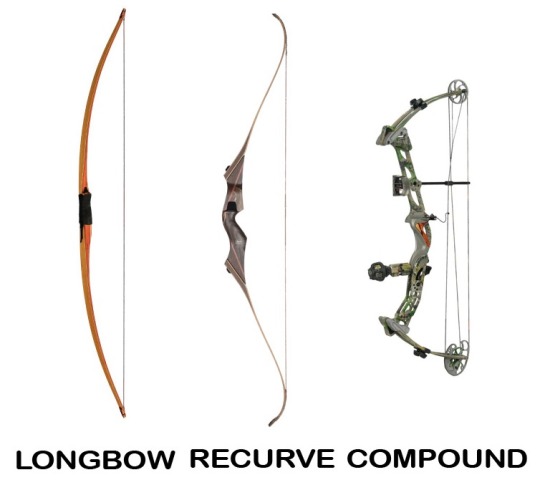
There are two different types of bows that are commonly called a longbow: English longbows, and flatbows (yes I’m considering flatbows a type of longbow to simplify things). English longbows are very large and have a very high draw weight (which means it’s hard to pull the sting back). These were used mainly by the English in the Middle Ages. Flatbows are typically smaller and have a lower draw weight as well as a slightly different profile. These were mainly used by Native American tribes such as the Hupa, the Karuk, and the Wampanoag, as well as prehistoric Europeans and the Finnish, among others. It is often seen in historical fiction and fantasy, and the English longbow is usually depicted as Robin Hood’s preferred bow type. I believe Katniss uses a flatbow in the beginning of Hunger Games, but don’t quote me on that.
Recurves have limbs that curve outwards and are smaller than longbows. Many, many cultures have used these, including but not limited to certain West-coast Native American tribes, the Mongols, the Scythians, the Greeks, the Turks, the Koreans, and the Chinese. Recurves can be made of either wood or of a combination of wood, horn, and glue, making them either composite or non-composite. These are the bows you typically see mounted archers using, and are often used in competitions today. It’s commonly seen in fantasy, and is the bow type used by Legolas, Tauriel, Katniss Everdeen in Mockingjay, Merida, Green Arrow has a lever action, and Hawkeye uses a silly collapsible one.
Compound bows are the most commonly used bow among hunters, are almost always made of fiberglass and either carbon fiber or aluminum, are Technical Looking, and pack the biggest punch for the least amount of effort. It’s a modern invention used worldwide. I don’t know where else to put this, but almost everyone who I know that shoots a compound uses something called a trigger release (pictured below) to draw back the string because it means your release is cleaner.
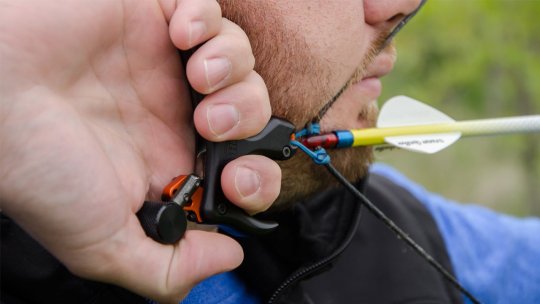
So, those are the main types of bow! Google which bow would be appropriat for the era and region your character is from, or if they’re from space or an alternate dimension, pick whichever you think fits the character the best.
Quivers
There are two types of quiver: back quivers, like Legolas wears, and hip quivers, like those used in the Olympics. Which quiver you should use varies from culture to culture and time period to time period. If it’s fantasy, set in modern day, or set in the future, you can chose whichever you prefer.
Arrows
Arrows can have shafts of wood or fiberglass, can have real feathers or synthetic for fletching, and can have countless different types of heads. The main two that are in use today are called field points and broadheads, and most commercial arrow shafts allow you to freely switch them out.
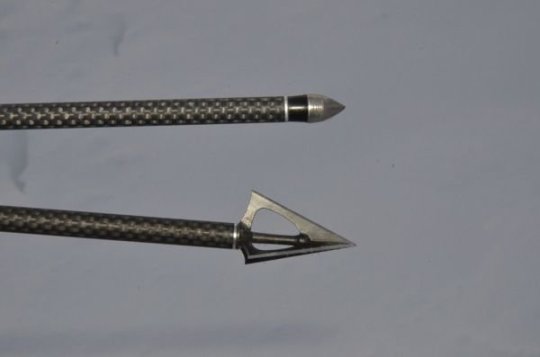
The arrow on the top is a field point, used only for target practice, and the arrow on the bottom is a broadhead, used only for hunting or war. You never hunt with a field point, and never practice with a broadhead. Basically every fictional character out there is shooting to kill, so they’ll all use either a broadhead, or a culturally appropriate variation of deadly arrowhead (bodkin, scythian, flint, etc). Do your research! A Native American wouldn’t use a bodkin, and a Scythian wouldn’t use a flint arrowhead!
Protective Equipment
The one really necessary piece of protective equipment is hand protection. If your character uses a three fingered draw or a pinch draw (we’ll speak on draws later), they need either an archery tab, or an archery glove. If your character is using a thumb draw, they need a thumb ring. These three pieces of equipment keep archers from getting blisters and damaged skin.

This is a tab.

This is the type of glove that I use. All an archery glove needs to do is protect your three draw fingers, but it can be more traditionally glove-like than this one. I’ve even seen ones that are a combination leather bracer and archery glove that give big Fantasy Vibes.

This is a ring. Some historical ones can get REAL ornate and pretty.
Another piece of protective equipment that is commonly used is an arm guard or a bracer. Not everyone uses one, because if your form is good the string should not be hitting your arm, so you can get away with not giving your character one. They can vary in style from something like the more minimal one below up to a full leather bracer.

Form
Form can vary greatly and I’m not about to diss other archery disciplines especially ones I’m ignorant on, so just know that not every culture has the same form. I’m just going to cover a few cultures’ variations, and what I’ve been taught by 21st century Midwest archers. There are several aspects to form, as form is just another term for “everything pertaining to how you shoot”. I’m going to break it down into stance, posture, draw, elbow discipline, holding the bow, and anchor. These are not the only aspects of form (there’s aiming, release, and breath control), but these are the only relevant aspects to drawing archers. I will not be covering mounted archery because I’m sadly ignorant on the topic. I recommend doing your own research and looking into Mongolian mounted archery.
Stance
The thing all stances have in common is that you should put your feet a shoulder-length apart, balance your weight equally between both feet, keep your knees slightly bent, and stand facing approximately 90 degrees away from your target. There are three stances that are common that I’m aware of: squared, open, and closed.

Squared stance means keeping both feet squared up to an imaginary line. Open means that you’re facing slightly towards the target. Closed means you’re facing slightly away. I vary between square and open, and to be honest I’ve never noticed a difference. So long as you draw your character standing with a stable stance, facing away from the target, you should be good.
Posture
Your posture should be with your back straight, your hips squared, and should never have you leaning. Below is one of my favorite archery pictures, not only because I love Marilyn, but because it is a great illustration of what not to do posture wise.
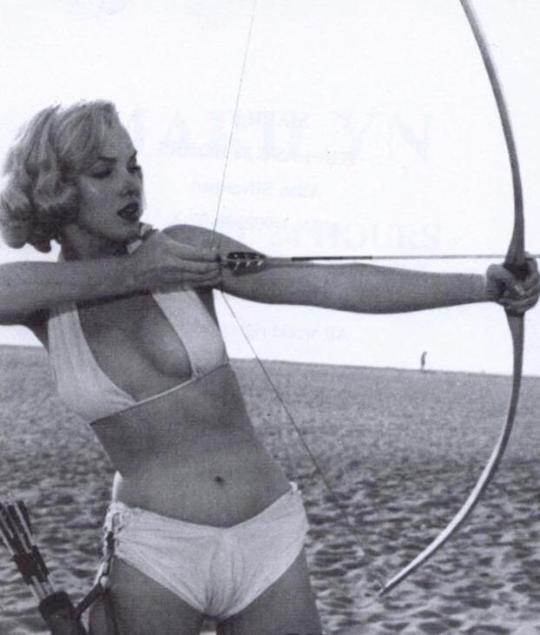
See how she’s leaning back? Yeah, don’t draw your character like that, it looks foolish.
Draw
There are four different types of draw that I’m aware of, I’m educated on three, and I have experience with one (though I’m itching to learn to thumb draw). The types of draw are three fingered draw, otherwise known as Mediterranean draw, pinch draw, thumb draw aka Mongolian draw, and Japanese draw, or torikake. I know fuck all about Japanese draws, so I’m not going to speak out of my ass on topics I don’t understand (if anyone reading practices traditional Japanese archery I would love if you chimed in!). I highly recommend doing your own research on which civilization your character comes from and which draw they use, especially if it’s Japanese because I’m not covering that here.

First up is three-fingered. This is the draw I use, and it’s the most common draw in my limited experience in the Midwestern archery community. It is common in Europe and the Middle East. It requires you to use three fingers, partially wrapped around the string. You do not pinch the arrow. Most people place their index finger above the arrow and their middle and ring finger below, though I’ve seen all different variations. If your character is right handed and uses this draw, draw the arrow on the left side of the bow. Lefties do the inverse, and make sure and draw a left handed bow while you’re at it.
Next is the pinch draw. I’ve never shot with this, nor seen it used. It was common in the Americas and for a time in Ancient Greece. You’re supposed to physically pinch the arrow between your thumb and index finger. Your character would need a full archery glove if you draw them with this grip. The release is supposed to be smooth because there’s only one point of contact, rather than three. I believe you would place the arrow on the right side of the bow when using this technique, but I cannot speak with certainty as I’ve never seen it done (again, lefties would do the opposite).
Last but not least is the thumb or Mongolian draw, though it is/was also widespread in Korea, China, Russia, Persia, Turkey, and the Roman and Byzantine Empires. In this draw you wrap your thumb completely around the string and tuck it behind your other fingers. You do not grab the arrow. This draw utilizes your strongest digit, and so it may be less strenuous than other draws. This draw is commonly used with mounted archery. If your character is right handed and using this draw, put the arrow on the right side of the bow (lefties, do the inverse).
Elbows
Another aspect of your draw that is important is elbow discipline. The elbow of your character’s string hand should not point up into the air. It should point straight back, like the picture below.
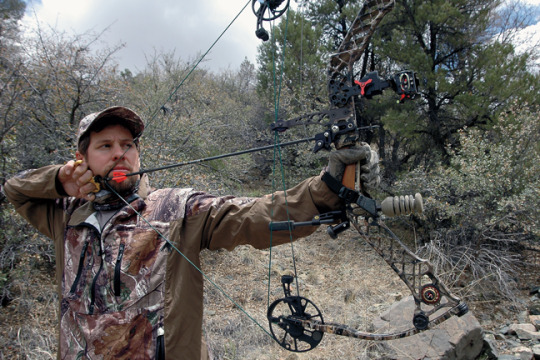
Now, the other elbow is important, too. Don’t draw them with a locked elbow, instead keep it slightly bent and rotated inwards, like the picture below.

Holding the Bow
Your character shouldn’t have a death grip on the bow. Instead, show it resting in the curve between the thumb and index finger. Here’s a wikihow article that describes the different ways to hold different types of bows that is more succinct than I could ever be. Ignore the crossbow (derogatory).
Anchor
Everyone needs an anchor. What’s an anchor, you ask? An anchor is a fixed spot that you draw your string back to whenever you’re going to shoot. It’s necessary in order to ensure consistency, which is accuracy’s best friend. Your anchor spot can vary. I anchor at the corner of my lip. Some people anchor underneath their chin. Some anchor to their ear. I’ve even seen some people in Asian disciplines anchor behind the ear or almost above the head, which is incredibly impressive. Bottom line, unless your character’s archery discipline has them draw behind the ear or above the head, you need to have them touching their head somewhere. The only wrong anchor is a short anchor. If you can’t draw the string back far enough to touch your face, that means you’re either trying to draw back a bow with too high a poundage, or the draw length is too short for you. The picture above of the person with the compound trigger release has a good anchor point on their face. The picture of the person with the arm guard has a good anchor point under their chin.
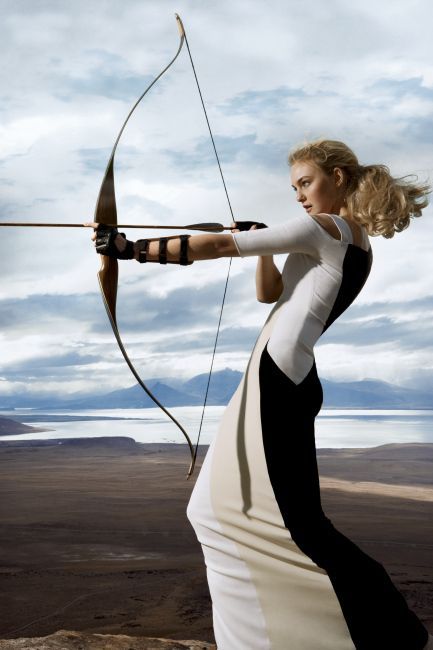
This person, on the other hand? Their anchor is out in space, that is to say they don’t have one (also their elbow discipline, posture, and stance are atrocious). I see this in fanart ALL THE TIME. It’s a pet peeve of mine. Don’t do this, have them anchor to their head or behind it somewhere.
Carrying The Bow
The best way is to just carry it in your hand by the bow (not the string). You can give your character a bow sling, or a back mount like Legolas has as well. You can slip the string over your shoulder and wear it across your back in a pinch, though this may damage the string. The only really wrong way to carry a bow is by the string, though you can damage your bow carrying it on your back if you’re stupid, and I’ve never tried to do so with a compound. Too pokey.
TL;DR
If you’re drawing a fantasy character, go buck wild. Still make sure to give them the right type of arrowhead, hand protection of some sort, a strong stance (no kneeling or sitting), good posture, a sensible draw, elbow discipline, an anchor point (don’t be like the person above!), and a good way to carry their bow, but you can have fun with the rest. If you’re drawing a character from history, research the archery discipline they would most likely use, and draw them with the appropriate bow type, quiver, arrows, protective equipment, stance, posture, draw, elbow discipline, anchor, and bow carry.
#archery#legolas#legolas greenleaf#lotr#tauriel#katniss everdeen#merida#green arrow#hawkeye#clint barton#robin hood#archer#bows#art reference#len speaks#holy FUCK it's complete!#i spent like five hours researching for this post jfc i'm beat#me: *sees one terrible piece of legolas fanart*#me: *cracks knuckles* tiME TO INFODUMP#anyways in conclusion fuck cr*ssbows uwu
1K notes
·
View notes